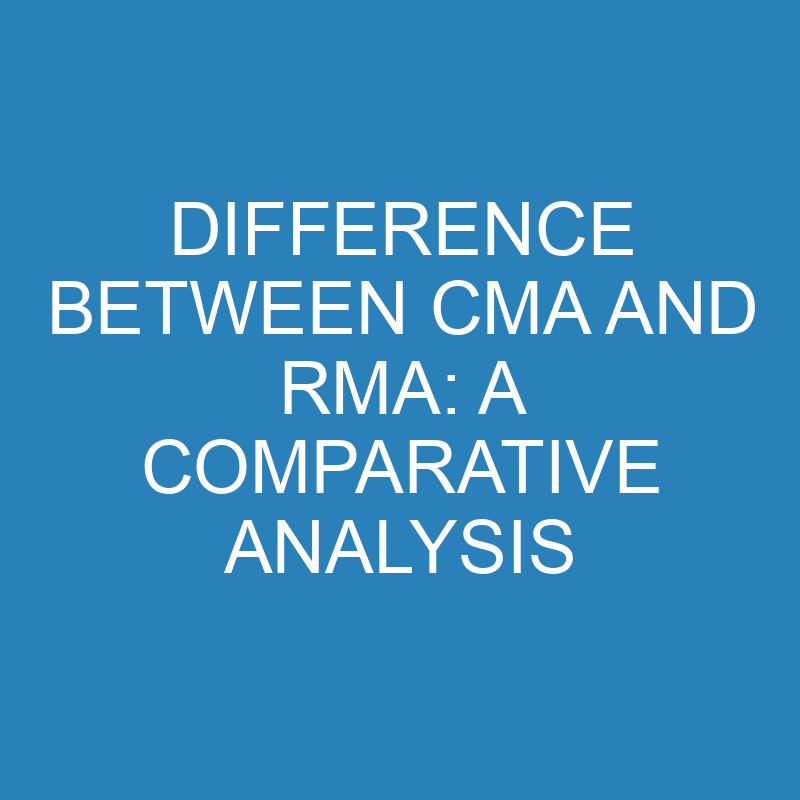
Are you curious about the differences between CMA and RMA? Well, look no further! In this article, I’ll break down the variances between these two popular certifications in the medical field.
First off, let’s start with CMA, which stands for Certified Medical Assistant. This credential is awarded by the American Association of Medical Assistants (AAMA) and is recognized nationwide. CMAs play a crucial role in healthcare settings, performing both administrative and clinical tasks. From scheduling appointments to taking vital signs, they are often considered the backbone of any medical practice.
On the other hand, we have RMA or Registered Medical Assistant. The RMA certification is offered by American Medical Technologists (AMT) and is also highly respected within the industry. Just like CMAs, RMAs can perform various administrative and clinical duties. However, one key difference lies in their eligibility requirements – RMAs can enter the profession through either formal education or work experience pathways.
So there you have it – a brief overview of CMA and RMA certifications. Whether you’re considering a career as a medical assistant or simply interested in expanding your knowledge on healthcare professions, understanding these distinctions can help guide your decision-making process. So let’s dive deeper into each certification to uncover more insights!
What is CMA? Well, let me break it down for you. CMA stands for Certified Medical Assistant. It’s a professional certification that validates an individual’s expertise in the field of medical assisting. As a CMA, I am trained to perform various administrative and clinical tasks in healthcare settings.
One of the key responsibilities of a CMA is to handle administrative duties, such as scheduling appointments, maintaining patient records, and managing billing and insurance claims. We ensure that the front office runs smoothly so that patients have a seamless experience when they visit the healthcare facility.
On the clinical side, CMAs are skilled in performing basic medical procedures under the supervision of physicians or other healthcare professionals. This includes taking vital signs, preparing patients for examinations, administering medications (with proper training), and conducting basic laboratory tests.
CMAs also play a crucial role in providing emotional support to patients by lending a listening ear and offering reassurance during their medical visits. We strive to create a compassionate environment where patients feel comfortable sharing their concerns and seeking guidance.
To become a CMA, one must complete an accredited medical assisting program and pass the certification exam administered by organizations like the American Association of Medical Assistants (AAMA). Maintaining certification requires ongoing education to stay up-to-date with advancements in healthcare practices.
In summary, being a Certified Medical Assistant involves having both administrative and clinical skills to support healthcare providers in delivering quality care to patients. It’s an important role that contributes significantly to the smooth functioning of medical facilities while ensuring patient comfort and well-being.
What is RMA?
RMA stands for Registered Medical Assistant. It is a professional certification that demonstrates an individual’s competency in various clinical and administrative tasks within the healthcare field. A Registered Medical Assistant plays a crucial role in maintaining smooth operations in medical facilities, such as hospitals, clinics, and physicians’ offices.
To become a Registered Medical Assistant, individuals have to complete an accredited training program and pass the certification exam administered by the American Association of Medical Assistants (AAMA). This rigorous process ensures that RMAs are equipped with the necessary knowledge and skills to provide high-quality patient care.
RMAs perform a wide range of duties that encompass both clinical and administrative responsibilities. On the clinical side, they assist healthcare providers with patient examinations, take vital signs, administer medications under supervision, collect laboratory specimens, and provide basic wound care. They may also conduct electrocardiograms (ECGs) or help with minor surgical procedures.
Administratively, RMAs handle tasks like scheduling appointments, managing electronic health records (EHRs), billing and coding for insurance purposes, maintaining inventory of medical supplies, and coordinating referrals for patients. Their versatile skill set allows them to contribute significantly to the efficient functioning of medical practices.
In summary, RMA is an acronym for Registered Medical Assistant – professionals who have completed specialized training programs and obtained certification through exams conducted by AAMA. They play an integral role in healthcare settings by providing essential support to healthcare providers while ensuring optimal patient care delivery.
Sure, I’ll keep that in mind. Here’s the section on the similarities between CMA and RMA:
Similarities between CMA and RMA
When comparing the Certified Medical Assistant (CMA) and Registered Medical Assistant (RMA) certifications, it becomes evident that these two credentials share several commonalities. Let’s delve into some key areas where CMA and RMA overlap:
- Educational Requirements: Both the CMA and RMA certifications require candidates to have a high school diploma or equivalent. Additionally, completion of an accredited medical assisting program is mandatory for eligibility.
- Clinical Skillset: Whether you’re a CMA or an RMA, you’ll find yourself utilizing similar clinical skills in your day-to-day work. These include taking patient vital signs, preparing patients for examinations, collecting specimens for laboratory testing, administering medications under supervision, and assisting with minor surgical procedures.
- Administrative Duties: Another area of similarity lies in administrative tasks performed by CMAs and RMAs. Both roles involve managing patient records, scheduling appointments, coordinating referrals to specialists or diagnostic tests, billing and coding procedures for insurance purposes, and maintaining medical office supplies.
- Work Settings: CMAs and RMAs can be found working in various healthcare settings such as hospitals, clinics, physician offices, urgent care centers, nursing homes, and even outpatient facilities. The versatility of these certifications allows professionals to adapt to different environments while performing their duties effectively.
- Professional Development: Continuing education is crucial for both CMAs and RMAs to stay updated with advancements in the field of medical assisting. Pursuing professional development opportunities through workshops or conferences ensures that individuals maintain their knowledge base while enhancing their skill set.
It’s essential to note that while there are similarities between CMA and RMA certifications, they also have some differences worth exploring further in our next section: “Differences between CMA and RMA.” Stay tuned for a comprehensive breakdown of the distinctions between these two credentials.
In summary, the CMA and RMA certifications share common educational requirements, clinical skillsets, administrative duties, work settings, and emphasize the importance of professional development. These similarities highlight the foundational knowledge required to excel in either role. However, it’s important to recognize that there are nuances that set them apart as well. Let’s explore those differences in our upcoming section.
Differences between CMA and RMA
Let’s delve into the distinctions between CMA (Certified Medical Assistant) and RMA (Registered Medical Assistant). While both roles are essential in the medical field, they have unique characteristics that set them apart. Understanding these differences can help aspiring professionals choose the path that aligns with their career goals.
Education and Certification:
- CMA: To become a Certified Medical Assistant, individuals must complete an accredited medical assisting program. This program covers various topics such as anatomy, physiology, medical terminology, and clinical procedures. Following completion of the program, candidates are required to pass the CMA certification exam administered by organizations like the American Association of Medical Assistants (AAMA).
- RMA: On the other hand, becoming a Registered Medical Assistant involves completing a medical assisting program from an accredited institution or gaining equivalent work experience. After fulfilling these requirements, candidates can sit for the Registered Medical Assistant examination offered by organizations like American Medical Technologists (AMT) to obtain their certification.
Scope of Practice:
- CMA: Certified Medical Assistants primarily work in ambulatory settings such as outpatient clinics or physician offices. They assist healthcare professionals in both administrative tasks like scheduling appointments and clinical duties like taking vital signs or preparing patients for examinations.
- RMA: Registered Medical Assistants also perform administrative and clinical tasks but often work in various healthcare settings such as hospitals, clinics, long-term care facilities, or urgent care centers. Their responsibilities may include administering medications under supervision, collecting specimens for laboratory testing, or performing electrocardiograms.
Professional Associations:
- CMA: As a Certified Medical Assistant, individuals can become members of professional associations like AAMA. These associations offer resources for continued education opportunities and networking within the medical assisting community.
- RMA: Registered Medical Assistants can join professional organizations such as AMT to stay updated with industry developments and access valuable resources specific to their field.
It’s important to note that the specific duties and responsibilities of CMAs and RMAs may vary depending on state regulations, employer requirements, and individual skills. By gaining a comprehensive understanding of these differences, individuals can make informed decisions about their career paths in the medical assisting profession.
Conclusion
In conclusion, the CMA and RMA certifications are both valuable in the field of medical assisting. While they have similarities, such as their focus on medical knowledge and clinical skills, there are also key differences that set them apart.
One major difference is the organizations that offer these certifications. The CMA certification is provided by the American Association of Medical Assistants (AAMA), while the RMA certification is offered by American Medical Technologists (AMT). It’s important to research and understand which organization aligns best with your career goals and aspirations.
Another difference lies in the eligibility requirements for each certification. To become a CMA, you must graduate from an accredited medical assisting program and pass a comprehensive exam. On the other hand, becoming an RMA requires either graduation from an accredited program or work experience in addition to passing an exam.
When it comes to job opportunities, both certifications can open doors for employment in various healthcare settings. However, certain employers may prefer one certification over the other based on their specific needs or industry standards. It’s essential to consider your desired work environment and potential employers’ preferences when choosing which certification to pursue.
Furthermore, maintaining these certifications requires ongoing commitment through continuing education units (CEUs). Both CMAs and RMAs must stay updated with advancements in medical practices and technologies by completing CEUs regularly. This ensures that certified professionals stay current with industry developments throughout their careers.
Overall, whether you choose to pursue a CMA or RMA certification depends on factors such as personal preference, educational background, professional goals, and employer requirements. Both certifications demonstrate competence in medical assisting skills and can enhance your career prospects within the field.
Remember to thoroughly research each certification program before making a decision and consult with professionals who hold these credentials for guidance. By obtaining either the CMA or RMA designation, you’ll be equipped with the necessary knowledge and skills to provide quality care as a medical assistant.






